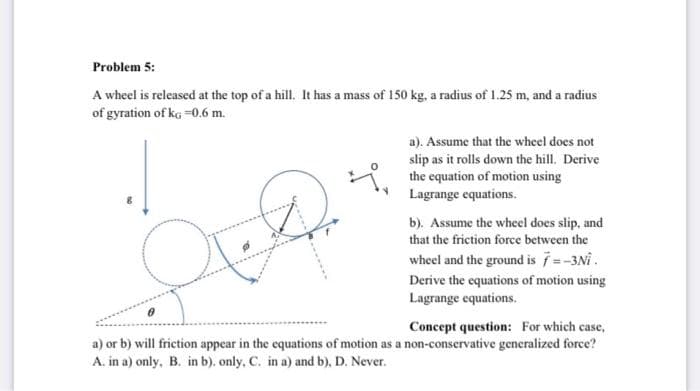Problem 5: A wheel is released at the top of a hill. It has a mass of 150 kg, a radius of 1.25 m, and a radius of gyration of kg -0.6 m. هما a). Assume that the wheel does not slip as it rolls down the hill. Derive the equation of motion using Lagrange equations. b). Assume the wheel does slip, and that the friction force between the wheel and the ground is 7 = -3Ni Derive the equations of motion using Lagrange equations. Concept question: For which case, a) or b) will friction appear in the equations of motion as a non-conservative generalized force? A. in a) only, B. in b). only, C. in a) and b), D. Never.
Problem 5: A wheel is released at the top of a hill. It has a mass of 150 kg, a radius of 1.25 m, and a radius of gyration of kg -0.6 m. هما a). Assume that the wheel does not slip as it rolls down the hill. Derive the equation of motion using Lagrange equations. b). Assume the wheel does slip, and that the friction force between the wheel and the ground is 7 = -3Ni Derive the equations of motion using Lagrange equations. Concept question: For which case, a) or b) will friction appear in the equations of motion as a non-conservative generalized force? A. in a) only, B. in b). only, C. in a) and b), D. Never.
Elements Of Electromagnetics
7th Edition
ISBN:9780190698614
Author:Sadiku, Matthew N. O.
Publisher:Sadiku, Matthew N. O.
ChapterMA: Math Assessment
Section: Chapter Questions
Problem 1.1MA
Related questions
Question

Transcribed Image Text:Problem 5:
A wheel is released at the top of a hill. It has a mass of 150 kg, a radius of 1.25 m, and a radius
of gyration of kg -0.6 m.
be
a). Assume that the wheel does not
slip as it rolls down the hill. Derive
the equation of motion using
Lagrange equations.
b). Assume the wheel does slip, and
that the friction force between the
wheel and the ground is 7 = -3Ni.
Derive the equations of motion using
Lagrange equations.
Concept question: For which case,
a) or b) will friction appear in the equations of motion as a non-conservative generalized force?
A. in a) only, B. in b). only, C. in a) and b), D. Never.
Expert Solution
This question has been solved!
Explore an expertly crafted, step-by-step solution for a thorough understanding of key concepts.
This is a popular solution!
Trending now
This is a popular solution!
Step by step
Solved in 5 steps

Knowledge Booster
Learn more about
Need a deep-dive on the concept behind this application? Look no further. Learn more about this topic, mechanical-engineering and related others by exploring similar questions and additional content below.Recommended textbooks for you

Elements Of Electromagnetics
Mechanical Engineering
ISBN:
9780190698614
Author:
Sadiku, Matthew N. O.
Publisher:
Oxford University Press

Mechanics of Materials (10th Edition)
Mechanical Engineering
ISBN:
9780134319650
Author:
Russell C. Hibbeler
Publisher:
PEARSON

Thermodynamics: An Engineering Approach
Mechanical Engineering
ISBN:
9781259822674
Author:
Yunus A. Cengel Dr., Michael A. Boles
Publisher:
McGraw-Hill Education

Elements Of Electromagnetics
Mechanical Engineering
ISBN:
9780190698614
Author:
Sadiku, Matthew N. O.
Publisher:
Oxford University Press

Mechanics of Materials (10th Edition)
Mechanical Engineering
ISBN:
9780134319650
Author:
Russell C. Hibbeler
Publisher:
PEARSON

Thermodynamics: An Engineering Approach
Mechanical Engineering
ISBN:
9781259822674
Author:
Yunus A. Cengel Dr., Michael A. Boles
Publisher:
McGraw-Hill Education

Control Systems Engineering
Mechanical Engineering
ISBN:
9781118170519
Author:
Norman S. Nise
Publisher:
WILEY

Mechanics of Materials (MindTap Course List)
Mechanical Engineering
ISBN:
9781337093347
Author:
Barry J. Goodno, James M. Gere
Publisher:
Cengage Learning

Engineering Mechanics: Statics
Mechanical Engineering
ISBN:
9781118807330
Author:
James L. Meriam, L. G. Kraige, J. N. Bolton
Publisher:
WILEY